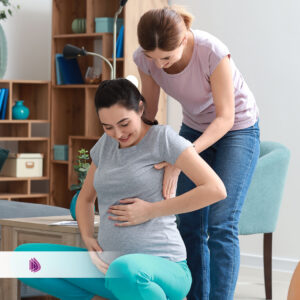ECVis a Massage-Based Approach for Turning Babies That are Breech


External Cephalic Version (ECV) is a good approach. During pregnancy, the developing baby moves around in the womb. Feeling regular movements is a sign of a healthy gestation. Ideally, as the pregnancy reaches its conclusion the baby will naturally end up in the cephalic position. This means that their head is downward facing, the chin is tucked in and they are facing the mother’s back. This is the optimal position for birth.
The non-optimal position
Not all babies adhere to this however, and by weeks 36-37 of pregnancy, 3-4% of babies will be in a breech position, meaning their head is up and either their bottom or feet are pointing down towards the vagina. Whilst in some cases of breech presentation, a vaginal birth is possible; it does have more risks than a normal vaginal delivery. For this reason, many women who find out their babies are breech opt to have an elective caesarean (C-section). A C-section is generally considered to be safer for the baby than a vaginal breech birth, but more risky than a normal vaginal birth.
Avoiding surgery
There is, however, an alternative to the C-section for women who find themselves in this position. The External Cephalic Version (ECV) is a manoeuvre during which gentle pressure is placed on the mother’s abdomen to move the baby into the correct position. The technique was first described in the 17th Century, however, only started being used widely towards the end of the 20th Century, due mainly to concerns about its safety. The advent of more advanced foetal monitoring systems, as well as the widespread use of drugs such as tocolysis. However, it relaxes the uterus, have garnered interest in the technique as an effective alternative to the C-section.
How is an ECV performed?
The ECV requires a trained doctor or midwife to ensure the procedure is carried out safely. Ultrasounds are used to confirm the exact positioning of the baby and drugs to relax the uterus are administered. Once the precise position is established, the doctor will apply firm pressure to the baby’s bottom, to lift it out of the pelvis and displace it laterally. Constant pressure is then applied simultaneously to the baby’s bottom and head as it is rotated round into the cephalic position. Normally a roll in the forward direction is attempted first and if this is unsuccessful the doctor will try rolling the baby backwards.
Success rates of ECV
If carried out in weeks 36/37 the success rate is about 50%. Although the procedure has a greater chance of being successful when used on women who have already given birth (multiparous) than first time mothers (nulliparous). Between 3 and 5% of babies who are successfully turned using ECV, revert back into a breech position prior to delivery.
Complications are rare. Minor complications include transient changes in the baby’s heart rate, ruptured membranes and small haemorrhages, and these happen in fewer than 5% of cases. Major complications, such as foetal death, placental abruption, severe foetal distress and cord prolapse occur in less than 0.5% of cases. This is favourable when compared to a foetal mortality/serious morbidity rate of 5% for breech babies delivered vaginally.
Is ECV suitable for everyone?
ECV is not suitable for all women; it will not be recommended for women with placental abnormalities, or those who have experienced bleeding, or whose waters have broken. It will also not be used on those women who are pregnant with twins or triplets. However, if you have no extenuating risk factors and your preference is for a vaginal birth, then it may be an option worth discussing with your doctor. The main priority being to find somebody who is well trained and highly experienced in the technique.
Nabta is reshaping women’s healthcare. We support women with their personal health journeys. From everyday wellbeing to the uniquely female experiences of fertility, pregnancy, and menopause.
Get in touch if you have any questions about this article or any aspect of women’s health. We’re here for you.
Sources:
- Paul, C. “The Baby is for Turning: External Cephalic Version.” BJOG, vol. 124, no. 5, Apr. 2017, p. 773., doi:10.1111/1471-0528.14238.
- Rodgers, R, et al. “Complications of External Cephalic Version: a Retrospective Analysis of 1121 Patients at a Tertiary Hospital in Sydney.” BJOG, vol. 124, no. 5, Apr. 2017, pp. 767–772., doi:10.1111/1471-0528.14169.
- “Breech Baby at the End of Pregnancy.” Royal College of Obstetricians & Gynaecologists, July 2017, www.rcog.org.uk/globalassets/documents/patients/patient-information-leaflets/pregnancy/breech-baby-patient-information-leaflet.pdf.













































